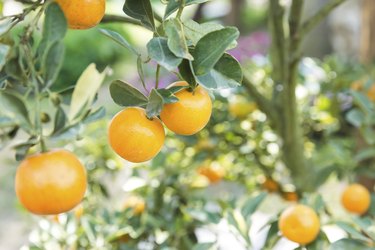
If you have difficulty recognizing the differences between tangerines and satsumas, you're not alone. Both are members of the larger mandarin orange family, according to the USDA, and are similar in most respects. Their names reflect the different routes taken by each fruit on its way to the West. Tangerines owe their name to the North African seaport of Tangiers, where they were trans-shipped to Western markets, while satsumas first came to the U.S. from the Japanese province of the same name.
Classification
Video of the Day
The USDA uses the system that categorizes mandarins into three groups: common mandarins, satsumas and mandarin hybrids. Tangerines are in the common mandarins group, which also includes clementines, and such tangerine varieties as Dancy, Honey, Pixie and Sunburst. Satsumas include the 200-plus varieties grown in Japan and other areas, and the most common U.S. varieties such as Kara, Owari and Silverhill. Mandarin hybrids includes tangelos, which are a cross between tangerines and pomelos, and tangors, a cross between tangerines and oranges.
Video of the Day
Appearance
Satsumas closely resemble clementines in size and appearance and are usually somewhat smaller than tangerines. All can have bumpy looking skin, but the tangerine's skin generally feels a bit smoother. Satsumas are among the earliest to mature in the fall, and sometimes are ready to eat while still green. Therefore, satsumas in the store may have some green on their skin, and are sometimes marketed as Emerald Green satsuma tangerines.
Peelability
Satsumas have what growers call "zipper skin" because it practically pops off with just a few pulls. Tangerines can be hand-peeled also, but their thinner, tighter skin makes them more difficult to peel. Both are easier to peel than oranges. Though easier to peel, their "zipper skin" can cause problems at harvest time. If they are not cut very carefully from the tree, their skin may tear, and the fruit may rot before it gets to the store.
Seed Count
One of the most noticeable differences between satsumas and tangerines is their seed count. Satsuma is described as nearly seedless, or having one and a half seeds per fruit. Dr. Steve George, a horticulturist with the Texas Cooperative Extension, contrasts this with the Chengsha tangerine -- an otherwise very similar fruit -- which averages 30 seeds. While a few varieties of tangerines have been cultivated to be seedless, most have numerous seeds.
Flavor
The satsuma is described as being very sweet, with a milder flavor than the tangerine, perhaps due to the satsuma's lower acidity. Children often prefer the satsuma over the tangerine for this reason. Taste is personal, however, and many adults prefer the tangerine precisely because it often has more tangy, acidic flavor.
- Texas A&M University Horticulture: Satsumas
- California Department of Public Health: Harvest Of the Month -- Mandarin Oranges
- University of Florida IFAS Extension; The Satsuma Tangerine; J.J. Ferguson, P.C. Andersen, and T.M. Spann; 2009
- Seasonal Chef: Japanese Satsumas Gain on Old-Fashioned Tangerines